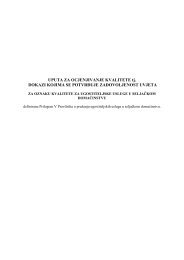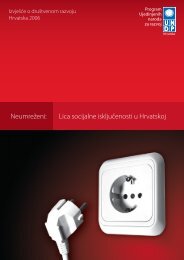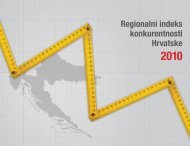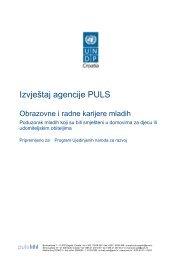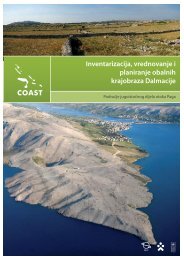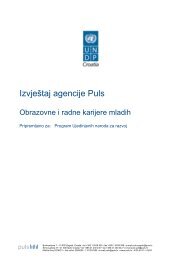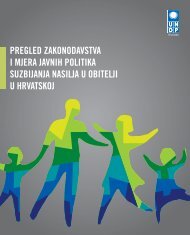THE SOCIALLY EXCLUDEDCHAPTER 3reflecting those individuals who have retired over thepast 5 years and who have lower pensions on averagethan those who had retired before this time in similaroccupations. The average <strong>Croatia</strong>n pension todayis approximately 42% of the average net income in<strong>Croatia</strong>. Therefore, the perspectives of those who arenow just entering into the age group of 65 and overare substantially worse than they once were.Based on their growing numbers, senior citizens inmost European countries have become an influentialinterest group. As such, they will have a strong say inmost of the important decisions in society, and willbe able to negotiate the most advantageous arrangementsfor their particular needs. If the elderly feelat ease in their present situation, they will be morelikely to use their influence to secure a long-termsustainable future, and focus less on their immediateshort-term needs. If, on the other hand, group membersfind themselves excluded and in dire need, theirdecisions will reflect this present situation instead.3.11.2 Access to Social ServicesThere are three types of social welfare institutions in<strong>Croatia</strong> that cater to the needs of senior citizens: theCSW, the social welfare residential institutions andsocial welfare service providers. According to the LabourForce Survey (2004) only 11,700 senior citizensreceived income from social welfare sources. Thebenefits range from assistance for heating, clothesand food, to the provision of funds, placement inhomes, and homecare. Table 6 illustrates the benefitsprovided by the <strong>Croatia</strong>n social system, and whatpercentage of the clientele are senior citizens.The household income of senior citizens comes fromvarious types of pensions, however 72.5% of thesehouseholds still require support from family members.A relatively small number of households receiveregular social assistance, but many take advantage ofthe many types of occasional benefits such as incomesupplements, subsidized heating in the winter, orTable 6: Household earnings of the 65+ group, by typeIncome %Support from family members or relatives72.5Old age pension67.5Family pension25.6Earnings from work (self-employment, agriculture, employment)24.5Financial support from persons outside the household18.4Income supplement13.9Disability pension8.6Savings6Social welfare benefit (cash)5.4Informal type of work (gray economy)3.9Child benefit2.7Unemployment benefit0.7Social welfare benefit (in kind)0.7Housing support0.6Persons who combine welfare with other sources of income LFS(2004)43.3Source: <strong>UNDP</strong> (2006). Research on social exclusion in <strong>Croatia</strong>: Quality of Life and the risk of social exclusion. <strong>UNDP</strong>, Zagreb, <strong>Croatia</strong>, CBS101
CHAPTER 3THE SOCIALLY EXCLUDED102homecare. The CSW are the main source of supplementalincome for 55% of cases, with local authoritiesproviding for these expenses in 9.5% of cases.The level of trust and satisfaction that senior citizenshave in the welfare system was rated below-averageby 36.6% of the senior citizens, 20.6% view the systemas more or less satisfactory, while 23.3% hold anabove average opinion of the services.3.11.3 Access to HealthcareHealth related risks seem to be disproportionately highamongst this social group. The highest risk of chronicillness seems to be negatively correlated with earnings,education level and rural/urban location. As many as37.3% of senior citizens view their health as impaired,while 52.9% have a chronic ailment which influencestheir everyday life. The elderly have a below averagelevel of satisfaction with their health (only 4.7 on ascale 1-10, where 10 is very satisfied). Men seem to beslightly more satisfied with their health than women.Discussions within focus groups revealed that seniorsstrongly protest the high costs of health services.Of special concern were the cash payments paid forevery visit to the doctor. Although small amounts,they accrue over time given that seniors visit doctorsfrequently. Also, seniors t<strong>end</strong> to need monthly prescriptionmedication, and to use services which werepreviously free such as blood pressure checks, whichnow cost 10 HRK per month - that is 5% of the averagepension. It is widely considered among senior citizensthat these costs are excessive compared to their incomeand should be discontinued.3.11.4 Access to Employment andEmployment ServicesThe incidence of low earnings in households ishigher in those which have senior family members,with women indicating lower incomes in generalas opposed to men. In view of their financial situation,41.79% of senior women and 31.2% of seniormen assess it as unfortunate. Only 31% of men whohave above average household incomes (7,000 HRK– 14,000 HRK) view this as a healthy income, while66.6% of women in this income bracket are satisfiedwith their earnings. Senior women are more susceptibleto poverty then are men; 8.9% of senior womenreceive less than 1,000 HRK per month, while only 3.4%of men fall within this income bracket. In the secondearnings bracket (1,000 HRK – 2,000 HRK), there are35.3% women and only 11.8% men. At the other <strong>end</strong>of the scale, 8.9% of men and only 3.8% of women livein households which earn more than 10,000 HRK.The majority of senior citizens live in two memberhouseholds, but those living alone indicate a particularlylow level of living standard. There are 244,000or 28.9% such households, 80% of which are elderlywomen living alone. About 45.1% of single memberhouseholds live on less than 1,500 HRK per monthand a further 46.7% have a monthly income of 1,500-3,000 HRK. Only 8.5% receive more than 3,000 HRK.This would indicate that within the senior citizensgroup in <strong>Croatia</strong> are subgroups that face an evengreater risk of exclusion. More than 2/3 of householdswhich are home to the elderly are either one or twomember households.Figure 12: Actual and needed levels of income by theelderly25.0020.0015.0010.005.000Actual incomeNeeded incomeDo 500 kn1001-15002001-30004001-50006001-70008001-1000012001-1400016001-1800020001-25000<strong>UNDP</strong> (2006). Research on social exclusion in <strong>Croatia</strong>: Quality of Life and therisk of social exlcusion. <strong>UNDP</strong>, Zagreb, <strong>Croatia</strong>.Figure 12 shows the difference between the actualand the needed income as expressed by <strong>Croatia</strong>n seniorcitizens. The amounts of actual incomes peakat levels which are considered to be unacceptablylow for maintaining a decent standard of living.Even those who receive the highest amounts haveexpressed dissatisfaction with their income, indicatingthat even wealthier senior citizens subsist on abelow-average income.



